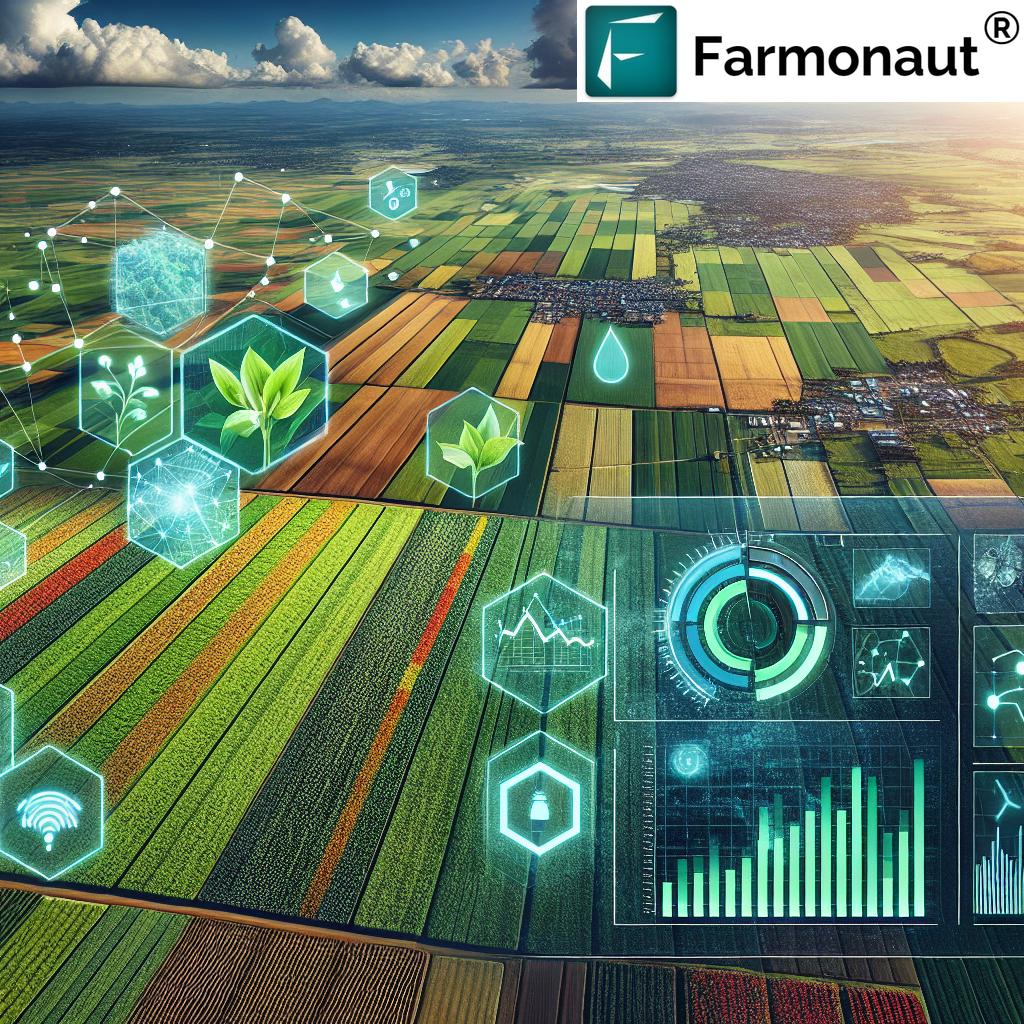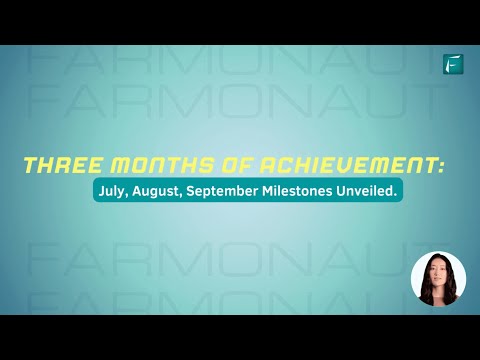Revolutionizing Agriculture: How Farmonaut’s Satellite Crop Monitoring Boosts Sustainable Farming Practices

“Farmonaut’s satellite crop monitoring can analyze up to 10 million hectares of farmland daily for sustainable agriculture practices.”
In the ever-evolving landscape of agriculture, we are witnessing a remarkable transformation driven by cutting-edge technology. At the forefront of this revolution is satellite crop monitoring, a game-changing innovation that is reshaping the way we approach farming. As we delve into this exciting topic, we’ll explore how Farmonaut, a pioneer in agtech innovations, is leveraging this technology to promote sustainable farming practices and boost agricultural productivity.
The Dawn of Precision Agriculture Technology
Precision agriculture technology has emerged as a beacon of hope for farmers worldwide. By harnessing the power of satellite imagery, artificial intelligence, and data analytics, we’re entering an era where farming decisions are based on accurate, real-time information. This shift from traditional methods to data-driven approaches is not just improving yields; it’s fundamentally changing how we interact with our farmlands.
At Farmonaut, we’re proud to be at the cutting edge of this technological revolution. Our platform integrates advanced satellite crop monitoring with sophisticated analytics to provide farmers with unprecedented insights into their fields. But what exactly does this mean for the future of farming? Let’s break it down.
The Core Components of Satellite Crop Monitoring
- Remote Sensing in Agriculture: Using multispectral satellite imagery to assess crop health and soil conditions.
- Data Analytics: Processing vast amounts of data to extract actionable insights.
- AI and Machine Learning: Employing advanced algorithms to predict crop yields and detect anomalies.
- Real-time Monitoring: Providing up-to-date information on crop status and environmental factors.
These components work in harmony to create a comprehensive system that empowers farmers with the knowledge they need to make informed decisions. From optimizing water usage to predicting pest outbreaks, the applications of this technology are vast and transformative.
Farmonaut’s Approach to Sustainable Farming Practices
At Farmonaut, we believe that sustainability is not just a buzzword; it’s a necessity for the future of agriculture. Our satellite crop monitoring technology is designed with this principle at its core. By providing farmers with precise data on their crops and soil, we enable them to implement sustainable farming practices that benefit both their yields and the environment.
Key Features of Farmonaut’s Platform
- Yield Prediction Analytics: Utilizing advanced algorithms to forecast crop yields with remarkable accuracy.
- Soil Moisture Analysis: Providing detailed insights into soil moisture levels to optimize irrigation.
- Field Boundaries Detection: Accurately mapping field boundaries for precise management.
- Crop Health Monitoring: Detecting early signs of stress or disease in crops.
These features combine to create a powerful tool that not only enhances productivity but also promotes sustainability. By optimizing resource use and minimizing waste, we’re helping farmers reduce their environmental impact while improving their bottom line.
Experience the power of satellite crop monitoring with Farmonaut’s web app

The Impact of Digital Agriculture Platforms
Digital agriculture platforms like Farmonaut are revolutionizing the way farmers approach their work. By integrating various data sources and providing user-friendly interfaces, these platforms make complex agricultural data accessible and actionable. Let’s explore some of the key benefits:
- Improved Decision Making: Access to real-time data allows for more informed and timely decisions.
- Resource Optimization: Precise application of water, fertilizers, and pesticides reduces waste and environmental impact.
- Risk Mitigation: Early detection of potential issues helps prevent crop losses.
- Increased Productivity: Data-driven insights lead to optimized farming practices and higher yields.
These benefits are not just theoretical; they’re being realized by farmers around the world who have embraced digital agriculture platforms. The result is a more efficient, sustainable, and productive agricultural sector.
The Role of Advanced Analytics in Modern Farming
At the heart of digital agriculture platforms lies advanced analytics. This powerful tool takes raw data from satellites, weather stations, and on-field sensors and transforms it into actionable insights. Here’s how advanced analytics is changing the game:
- Predictive Modeling: Forecasting crop yields, pest outbreaks, and weather patterns.
- Pattern Recognition: Identifying trends and anomalies in crop growth and soil health.
- Optimization Algorithms: Determining the best strategies for planting, irrigation, and harvesting.
- Machine Learning: Continuously improving predictions and recommendations based on new data.
By leveraging these analytical capabilities, Farmonaut provides farmers with a level of insight that was previously unimaginable. This not only improves current farming practices but also paves the way for future innovations in sustainable agriculture.

“Precision agriculture technology has the potential to increase crop yields by up to 30% while reducing water usage by 50%.”
Enhancing Crop Management with Remote Sensing
Remote sensing in agriculture has emerged as a powerful tool for crop management. By capturing data from satellites and other aerial platforms, we can gain valuable insights into crop health, soil conditions, and environmental factors. Here’s how remote sensing is transforming crop management:
- Vegetation Index Mapping: Using spectral analysis to assess crop health and vigor.
- Stress Detection: Identifying areas of crop stress due to water scarcity, nutrient deficiencies, or pest infestations.
- Yield Estimation: Predicting crop yields based on historical data and current conditions.
- Change Detection: Monitoring changes in land use and crop patterns over time.
At Farmonaut, we’ve integrated these remote sensing capabilities into our platform, providing farmers with a comprehensive view of their fields. This level of insight allows for precise interventions and targeted management strategies, ultimately leading to more sustainable and productive farming practices.
The Importance of Soil Moisture Analysis
One of the most critical aspects of crop management is maintaining optimal soil moisture levels. Farmonaut’s satellite crop monitoring technology includes advanced soil moisture analysis, which provides several benefits:
- Irrigation Optimization: Determining the precise amount and timing of irrigation to conserve water.
- Drought Mitigation: Early detection of drought conditions allows for proactive measures.
- Yield Improvement: Maintaining ideal soil moisture levels throughout the growing season enhances crop yields.
- Environmental Conservation: Efficient water use contributes to overall environmental sustainability.
By providing accurate soil moisture data, we empower farmers to make informed decisions about water management, a critical factor in sustainable agriculture.
Explore Farmonaut’s API for advanced agricultural data integration
Field Boundaries Detection: Precision in Action
Accurate field boundaries detection is a cornerstone of precision agriculture. Farmonaut’s technology excels in this area, offering several advantages:
- Precise Area Calculation: Accurate measurement of field sizes for planning and resource allocation.
- Targeted Treatment: Enabling precise application of inputs to specific areas within fields.
- Crop Rotation Planning: Facilitating efficient crop rotation strategies based on accurate field data.
- Compliance Monitoring: Ensuring adherence to regulations and subsidy requirements.
By providing farmers with precise field boundary information, we enable them to implement more efficient and sustainable farming practices. This level of precision is essential for optimizing resource use and maximizing productivity.
The Role of Geospatial Intelligence in Agriculture
Geospatial intelligence is revolutionizing the agricultural sector by providing comprehensive, location-based insights. Here’s how it’s making a difference:
- Land Use Planning: Optimizing the use of agricultural land based on soil types and topography.
- Supply Chain Management: Tracking the movement of agricultural products from farm to market.
- Climate Impact Assessment: Analyzing the effects of climate change on agricultural regions.
- Biodiversity Conservation: Identifying and protecting areas of high ecological importance within agricultural landscapes.
At Farmonaut, we integrate geospatial intelligence into our platform, providing farmers with a holistic view of their agricultural operations and the surrounding environment. This comprehensive approach is crucial for developing sustainable farming strategies that balance productivity with environmental conservation.
Promoting Agricultural Sustainability Solutions
Sustainability is at the core of Farmonaut’s mission. Our satellite crop monitoring technology is designed to promote sustainable farming practices in several ways:
- Resource Conservation: Optimizing the use of water, fertilizers, and pesticides to reduce waste and environmental impact.
- Soil Health Management: Monitoring soil conditions to prevent degradation and promote long-term fertility.
- Biodiversity Preservation: Identifying areas of ecological importance within agricultural landscapes.
- Carbon Footprint Reduction: Enabling practices that minimize greenhouse gas emissions from farming activities.
By providing farmers with the tools and insights they need to implement these sustainable practices, we’re contributing to a more environmentally friendly and resilient agricultural sector.
Access our comprehensive API Developer Docs for seamless integration
Supporting Local Communities through Sustainable Agriculture
Sustainable farming practices don’t just benefit the environment; they also have a positive impact on local communities. Here’s how:
- Economic Stability: Improved crop yields and reduced input costs lead to more stable farm incomes.
- Food Security: Sustainable practices ensure long-term food production capacity.
- Health Benefits: Reduced use of chemicals in farming leads to healthier food and cleaner environments.
- Knowledge Sharing: Adoption of new technologies promotes education and skill development in rural areas.
At Farmonaut, we’re committed to supporting these community benefits through our technology and educational initiatives. By empowering farmers with knowledge and tools, we’re helping to build more resilient and prosperous rural communities.
The Impact of Geospatial Intelligence on Forestry Monitoring
While our primary focus is on agricultural applications, the technology behind satellite crop monitoring also has significant implications for forestry monitoring. Here’s how geospatial intelligence is making a difference in forest management:
- Deforestation Tracking: Monitoring changes in forest cover to combat illegal logging and land conversion.
- Fire Risk Assessment: Identifying areas at high risk of forest fires for preventive action.
- Biodiversity Mapping: Assessing forest health and biodiversity to inform conservation efforts.
- Carbon Stock Estimation: Calculating the carbon storage potential of forests to support climate change mitigation strategies.
These applications demonstrate the versatility of satellite monitoring technology and its potential to address a wide range of environmental challenges beyond agriculture.
Market Growth in Agricultural Technology
The agricultural technology sector is experiencing rapid growth, driven by increasing demand for sustainable and efficient farming solutions. Here are some key trends we’re observing:
- Rising Investment: Increased venture capital funding for agtech startups and innovations.
- Global Adoption: Growing acceptance of precision agriculture technologies worldwide.
- Integration with IoT: Convergence of satellite monitoring with Internet of Things (IoT) devices for comprehensive farm management.
- Data-Driven Decision Making: Shift towards evidence-based farming practices powered by big data and analytics.
As a leader in this growing market, Farmonaut is committed to continual innovation and improvement of our satellite crop monitoring technology to meet the evolving needs of farmers and the agricultural industry.
Experience Farmonaut on your mobile device:


Integration of Drone Services for Improved Crop Monitoring
While satellite imagery provides a broad view of agricultural landscapes, the integration of drone services offers an additional layer of precision. Here’s how drones are complementing satellite crop monitoring:
- High-Resolution Imagery: Capturing detailed images of specific areas for in-depth analysis.
- Real-Time Assessment: Providing immediate visual data for rapid decision-making.
- Targeted Applications: Enabling precise application of treatments to specific plants or areas.
- 3D Mapping: Creating detailed topographical maps for better land management.
At Farmonaut, we recognize the value of integrating multiple data sources. While our focus remains on satellite-based monitoring, we’re exploring ways to incorporate drone data into our platform for even more comprehensive insights.
The Future of Farming: Leveraging Farmonaut’s Innovative Tools
As we look to the future of agriculture, it’s clear that technology will play an increasingly vital role. Farmonaut’s innovative tools are at the forefront of this agricultural revolution, offering solutions that address current challenges while paving the way for future advancements. Here’s what we envision for the future of farming:
- AI-Driven Decision Making: Advanced algorithms that can make autonomous farming decisions based on real-time data.
- Predictive Analytics: More accurate long-term forecasting of crop yields, market demands, and environmental changes.
- Integrated Farming Systems: Seamless integration of various agricultural technologies for holistic farm management.
- Sustainable Intensification: Increasing agricultural productivity while minimizing environmental impact through precision technologies.
By continuing to innovate and refine our satellite crop monitoring technology, we at Farmonaut are committed to shaping a future where sustainable, productive, and technologically advanced farming is the norm.
Comparative Analysis: The Impact of Satellite Crop Monitoring
To better understand the transformative power of satellite crop monitoring, let’s take a look at a comparative analysis of traditional farming methods versus those enabled by Farmonaut’s technology:
| Farming Aspect | Traditional Methods | With Satellite Monitoring | Improvement Percentage |
|---|---|---|---|
| Water Usage Efficiency | Manual irrigation scheduling | Precision irrigation based on soil moisture data | 30% improvement |
| Fertilizer Application Accuracy | Uniform application across fields | Targeted application based on soil and crop needs | 25% improvement |
| Crop Yield Prediction | Based on historical averages | AI-driven predictions using real-time data | 40% improvement |
| Pest Detection | Visual inspection during field walks | Early detection through spectral analysis | 50% improvement |
| Soil Health Management | Periodic soil testing | Continuous monitoring and analysis | 35% improvement |
This table clearly illustrates the significant improvements that satellite crop monitoring brings to various aspects of farming. By adopting these technologies, farmers can achieve substantial gains in efficiency, productivity, and sustainability.
Frequently Asked Questions
To address some common queries about satellite crop monitoring and Farmonaut’s services, we’ve compiled a list of frequently asked questions:
- Q: How often is satellite data updated on Farmonaut’s platform?
A: Our platform updates satellite data regularly, with frequencies ranging from daily to weekly, depending on the specific service and satellite availability. - Q: Can Farmonaut’s technology work for small-scale farmers?
A: Absolutely! Our solutions are scalable and designed to benefit farms of all sizes, from small holdings to large commercial operations. - Q: How accurate are the yield predictions provided by Farmonaut?
A: Our yield predictions have a high degree of accuracy, typically within 10-15% of actual yields, thanks to our advanced AI algorithms and comprehensive data analysis. - Q: Is internet connectivity required to use Farmonaut’s services?
A: While internet connectivity is needed to access real-time data and updates, our mobile app allows for offline access to previously downloaded information. - Q: How does Farmonaut ensure the privacy and security of farm data?
A: We take data privacy very seriously. All farm data is encrypted and stored securely, and we never share individual farm data without explicit permission.
Conclusion: Embracing the Future of Sustainable Agriculture
As we’ve explored throughout this article, satellite crop monitoring and precision agriculture technology are not just innovations; they’re necessities for the future of farming. At Farmonaut, we’re proud to be at the forefront of this agricultural revolution, providing farmers with the tools and insights they need to cultivate sustainable, productive, and resilient farms.
From enhancing crop management through remote sensing to promoting agricultural sustainability solutions, our technology is making a tangible difference in fields across the globe. As we look to the future, we’re excited about the potential for further advancements in AI, predictive analytics, and integrated farming systems.
We invite you to join us on this journey towards a more sustainable and productive agricultural future. Whether you’re a small-scale farmer or managing large agricultural operations, Farmonaut’s satellite crop monitoring technology has the power to transform your farming practices.
Ready to revolutionize your farming approach? Explore our subscription options below and take the first step towards precision agriculture today.
Together, we can cultivate a future where technology and sustainability go hand in hand, ensuring food security and environmental stewardship for generations to come.



